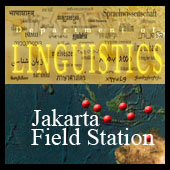| (The Former) Jakarta Field Station of the Max Planck Institute for Evolutionary Anthropology | |
 | |
| Data | |
| Projects | |
| Language Acquisition | |
| Bilingual Language Acquisition | |
| Language Contact | |
| Language Description | |
| Language Experiments | |
| Javanese Dialectology | |
| Metaphor and Emotion | |
| Collaborative Projects | |
| Documentation of Kenyah | |
| Figurative Language | |
| Language and Thought | |
| Phon. of Jakarta Indonesian | |
| Traditional Jambi Malay | |
| Moluccan [external link] | |
| Acquisition of Passive Voice | |
| Sociolinguistic Questionnaire | |
| Former Collaborative Projects | |
| Acq. of Morpho-phonology | |
| Publications & Conf. Papers | |
| News | |
| Regular Events | |
| Events | |
| The Jakarta Forum | |
| Contact Us | |
| People | |
| Site Map | |
| Links | |
| Impressum | |
Traditional Jambi Malay
Outside Scientists:
Peter Cole [external link], University of Delaware
Gabriella Hermon [external link], University of Delaware
Outside Research Assistant:
Yanti, University of Delaware
MPI Scientist:
Uri Tadmor
This project studies Traditional Jambi Malay, an endangered Malay variety spoken in Jambi Province in southeast Sumatra, Indonesia. The PI/co-PIs are Peter Cole and Gaby Hermon of the University of Delaware, and Uri Tadmor of the Max Planck Institute for Evolutionary Anthropology. The are assisted by Yanti, former research assistant at the Jakarta Field Station and native of Jambi, who is currently pursuing a doctoral program at the Univesity of Delaware.
The Malay language originated in Sumatra, and dozens of Malay dialects are spoken on the island, none of which have been well described. Most native speakers of Malay live in Sumatra, many more than in Malaysia, for example. Yet there is not even one thorough grammatical description of a Sumatran Malay dialect. One of the expected results of this project would be the first detailed description of such a dialect.
Traditional Jambi Malay is an ideal dialect for a study, because Jambi is widely considered to be original locus of Malayu/Melayu (the Malay-Indonesian term for ‘Malay'). It was from Jambi--and later from Palembang--that Malay spread throughout much of Southeast Asia. Thus, Jambi is an important key to understanding the complex diasystem of hundreds of Malay dialects. While Jambi Malay as a whole is not in immediate danger of extinction, conservative varieties of the language are being rapidly replaced by an urban koine, which is spreading from Jambi City. As a result of the koineization process, many of the distinctive features of Jambi Malay have been lost in Jambi City. As this process spreads to the hinterland, Traditional Jambi Malay will eventually cease to exist.
In addition to grammatical description of Traditional Jambi Malay, the long-term results of this project are expected to include:
This collaborative project is made possible by funding from the U.S. National Science Foundation, grant number BCS0444649, and from the Max Planck Institute for Evolutionary Anthropology.
Last modified: 20 May 2005
Location: jambi_malay.php.html